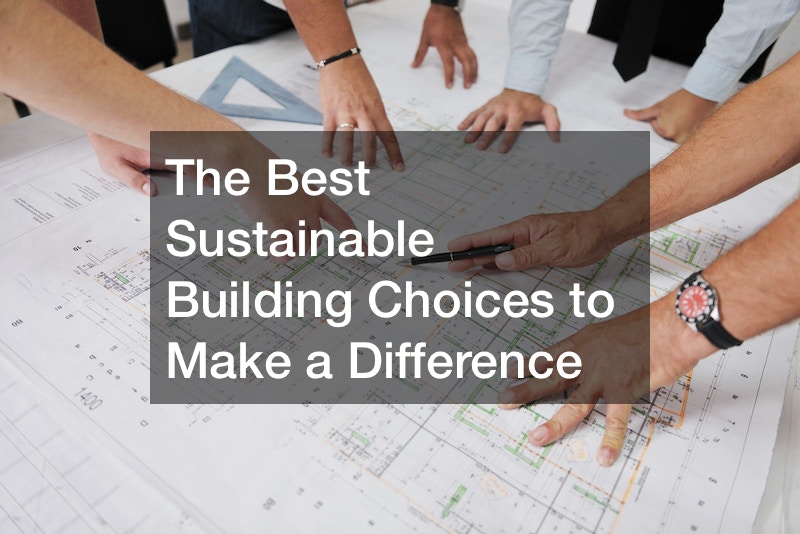
When it comes to sustainable building, there are several options you can find on the market. Some developers may attempt to construct buildings by utilizing local materials as much as possible, while others may prefer more sustainable building practices like purchasing environmentally-friendly building materials. Ideal sustainable building options highly depend on the construction project’s specific needs and resources at your disposal. Whether you own a commercial building, are looking to renovate your home, or are a contractor, there are several things you can do to ensure your building is sustainable. Here are some of the best sustainable building choices you can implement in your construction project.
Sustainable Building Materials

Choosing the best sustainable building materials can significantly affect how you build your home. By using sustainable or recycled materials, you’ll establish an eco-friendly environment while saving costs on your energy bills. You can also reduce the amount of ds up in a landfill.
One of the best sustainable building choices you can make as a homeowner is using concrete to construct steel buildings. It’s a strong, durable, and affordable material that’s easy to work with and recycle. However, various adverse effects are associated with the manufacturing and disposal of concrete. The building industry is one of the main contributors to greenhouse gas emissions. It’s vital to develop sustainable building materials to reduce these emissions. Bamboo is one example of a natural building material that mainly thrives in subtropical and temperate climates. It’s useful for decorative and structural building purposes. It’s also compostable, producing less waste when building your home.
Hemp is another type of plant used to create sustainable building materials. It’s harvested and processed before its woody core, known as shiv, is molded into hollow or solid structures like bricks. It’s also an ideal insulation material if you’re looking for the best sustainable building choices. You can find recycling building materials in various sources. For instance, you can purchase cinder blocks from plastic bags as a recycled building material.
Furthermore, the latest technologies make it more straightforward to create the best sustainable building materials from plant sources or biocomposites. An example of a building material made of biocomposites includes recycled rubber mulch, which is an ideal option for construction because it is resistant to the weather. Biodegradable insulation is another material you can use to build a sustainable home. For a natural or non-toxic fire-resistant material, consider purchasing wool as a biodegradable insulation material. It contains no bromine or formaldehyde, and it can assist in preventing mold growth in your residence.
Alternative Energy
Using alternative energy is an ideal way to reduce your carbon footprint and reduce health risks associated with air pollution. It can also save you costs when budgeting for your building project. There are several types of alternative energy you can select for your project. Harnessing wind power is a perfect example of alternative energy. Energy captured during the process gets converted to electricity, which you can use for various applications. Windmills are usually suitable for coastal areas, where production can occur on a large industrial scale due to the breeze.
Another example of the best sustainable building choices is installing solar panels, which you can install in the home to reduce costs on your energy bill. Solar energy is a perfect way to reduce your utility bill and help conserve the environment. Some building constructions even incorporate photovoltaic panels or geothermal system installation to generate on-site solar power for their building project. Combining the usage of various alternative sources of energy is a perfect way to save costs and decrease your home’s or business’s carbon footprint. Some states have passed laws to promote regulations for alternative energy. These laws may also include several tax credits applicable to solar panel installations.
One main challenge in implementing alternative energy is selecting an ideal location. You must consider your area’s zoning and other laws. You should also contemplate how you’ll utilize your building. For instance, if your facility will house many people, you should consider combining solar and wind energy. You should also consider using a renewable energy system to power specific loads like refrigeration or air conditioning.
An excellent way to determine the best sustainable building choices is to consult your contractor and design team. They can recommend an appropriate combination of renewable energy sources that are perfect for your building’s location. It’s also wise to research which alternative energy is suitable for your project. Some areas are ideal for wind energy, while others are more compatible with solar energy.
Saving on Heating and AC

Whether you’re a professional or new to building projects, there are various things you can do to save on your heating and AC bills. One of the best sustainable building choices to save energy expenses is ensuring the building project adheres to energy efficiency standards. It will assist you in saving costs on energy bills while also conserving the environment. Most of the construction industry is under pressure to provide for the growing demand for sustainable building materials. It includes ensuring appliances utilized are energy efficient, which assists in reducing the amount of energy your building project consumes.
One of the excellent ways to save on heating and AC bills is to purchase a highly efficient heating and cooling system. These systems come in various designs that provide small environmental footprints. For instance, an electric cooling system will likely offer you significant energy savings on your monthly bills than a traditional air conditioner. You can also save heating and AC bills costs by utilizing green building materials or installing solar shades. These materials assist in reducing energy consumption while also decreasing the building’s carbon footprint. You can find these materials at reasonable prices at various home improvement and construction stores.
Another energy-saving tip is to select a suitable site for your building project. An ideal location for sustainable building is nearby water bodies, such as a lake or stream. It’s also advisable to avoid building a home in a wilderness area because you can leave a significant carbon footprint than building a home in a suburban area. Installing attic insulation made of recycled materials is one of the best sustainable building choices you can utilize in your building project. An ideal type of insulation will assist in cooling your building in warmer climates while maintaining warmth in colder ones.
Furthermore, it’s also ideal for incorporating landscaping to keep your building cool. For instance, if you’re constructing a building in a warm climate, installing awnings to block the sun and allow breezes to flow into the structure makes sense. A well-designed building is also an ideal source of natural light. It will assist in reducing energy usage and utilizing artificial lighting required to light the building up. It’s also wise to contemplate building your home in a greener jurisdiction, such as an area close to a water body or urban area. Finally, it’s advisable to consider installing a renewable energy system in your building. These systems, such as wind power and solar energy, reduce how much energy you’ll need to operate your facility.
Proper Disposal

A proper disposal management plan is one of the best sustainable building choices for your construction project. Whether you’re remodeling a home or constructing a new building, you must consider the consequences of your building project. For instance, improper waste disposal may result in health hazards, water pollution, and air pollution. If you’re building a sustainable building, you can avoid pollution by planning your design and purchasing environmentally-friendly building materials. A sustainable building design can assist you in saving costs by minimizing energy use during construction and ensuring you adhere to local regulations regarding waste and recycling.
Additionally, you can save costs by having proper waste disposal in place for your building project. In contrast, most construction businesses dump their waste in landfills, and some implement an effective waste management strategy like hiring a local recycling company. If you’re constructing a building or home, you can also save costs by recycling your old building materials and reusing the recycled materials for various applications. Choosing the ideal building materials and using sustainable building design can reduce your project’s environmental impact and increase its resiliency.
Outdoor Work
Outdoor work is one of the best sustainable building choices for various reasons. One of the primary reasons outdoor work is a sustainable building choice is that it reduces your carbon footprint. When you use materials already on site and utilize natural resources, you expend less energy in the production process. It means the overall energy the building embodies lowers, which benefits the environment.
Another reason outdoor work is an ideal sustainable building choice is that it improves air quality. Indoor air quality can be worse than outdoor air quality during a construction project, so by working outdoors, and you can significantly improve the air you breathe in. It’s especially crucial if you reside in an area experiencing high air pollution. Finally, outdoor work is vital because it enables you to remain connected to nature and worry less about pest control. You can consult local landscape designers to create a yard that supports local wildlife and repel invasive animal species.
There are several ways you can establish outdoor work in your building project. One way to implement outdoor work is to create a green roof. Green roofs are becoming increasingly prevalent due to their various benefits. Not only do they save costs on energy bills by providing insulation, but they also help improve air quality and decrease your carbon footprint. You can also create an outdoor workspace by setting up tables and chairs in your backyard. It’s an excellent way to get fresh air and enjoy the outdoors while you work on your project. If you’re looking for a sustainable building choice, outdoor work is one perfect example you can implement. Not only will you improve your overall health and well-being, but you’ll also conserve the environment.
Responsible Maintenance

Responsible maintenance is another example of one of the best sustainable building choices. First, it reduces the need for new construction every time a building deteriorates due to negligence. It’s because when a construction project is underway, there’s a high demand for new materials, which can strain the environment. You can reduce the need for new construction projects by maintaining existing buildings.
Second, responsible maintenance is beneficial because it saves costs. By supporting existing buildings, you can save costs and reinvest in other projects, like ensuring your facility receives the assistance of a septic tank pumping service to protect the environment from being contaminated with harmful waste. Thirdly, responsible maintenance is one of the best sustainable building choices because it helps to maintain a community’s character. When a new construction project takes place, it can significantly change a community’s appearance and ambiance. By maintaining buildings, you can assist in preserving your community’s character and appearance.
There are several ways you can implement responsible maintenance in your building project. First, you can use environmentally-friendly cleaning products. Environmentally-friendly cleaning products usually come from natural ingredients and are effective in cleaning without causing harm to the environment. Second, you can invest in using recycled materials. Recycled materials are an ideal way to save costs and reduce waste. Third, you can install energy-efficient lighting. Energy-efficient lighting utilizes less energy and can save you costs on your monthly electric bill. Finally, consider installing water-efficient fixtures. Water-efficient fixtures are perfect because they use less water and help save costs on your water bill. It can be challenging to keep your facility running at peak performance. Unexpected repairs can add to the costs of maintaining a building. You should implement a regular maintenance routine to ensure your facility is as energy efficient as possible. You can achieve this by outsourcing tasks to a facility maintenance company or implementing an asset management program. By making responsible maintenance a priority, you can reduce your building’s environmental impact, save costs, and preserve your community’s character and appearance.
Choosing sustainable building materials is an essential part of the building design procedure. It assists you in achieving your building’s design goals within your financial budget. It also reduces how much waste your building will. Purchasing durable materials reduces the amount of material you’ll replace over your building’s lifetime and reduce your project’s cost. Choosing what sustainable building materials you should purchase isn’t an easy task. First, you must create a budget based on your facility’s design goals. You must also consider what the materials comprise by researching how they’re manufactured and their sources. Additionally, it’s vital to consider how you can recycle your materials as it can reduce how much waste you produce and make your materials less expensive. It will assist you in keeping your building operating as efficiently as possible, which reduces how much waste your facility produces.



